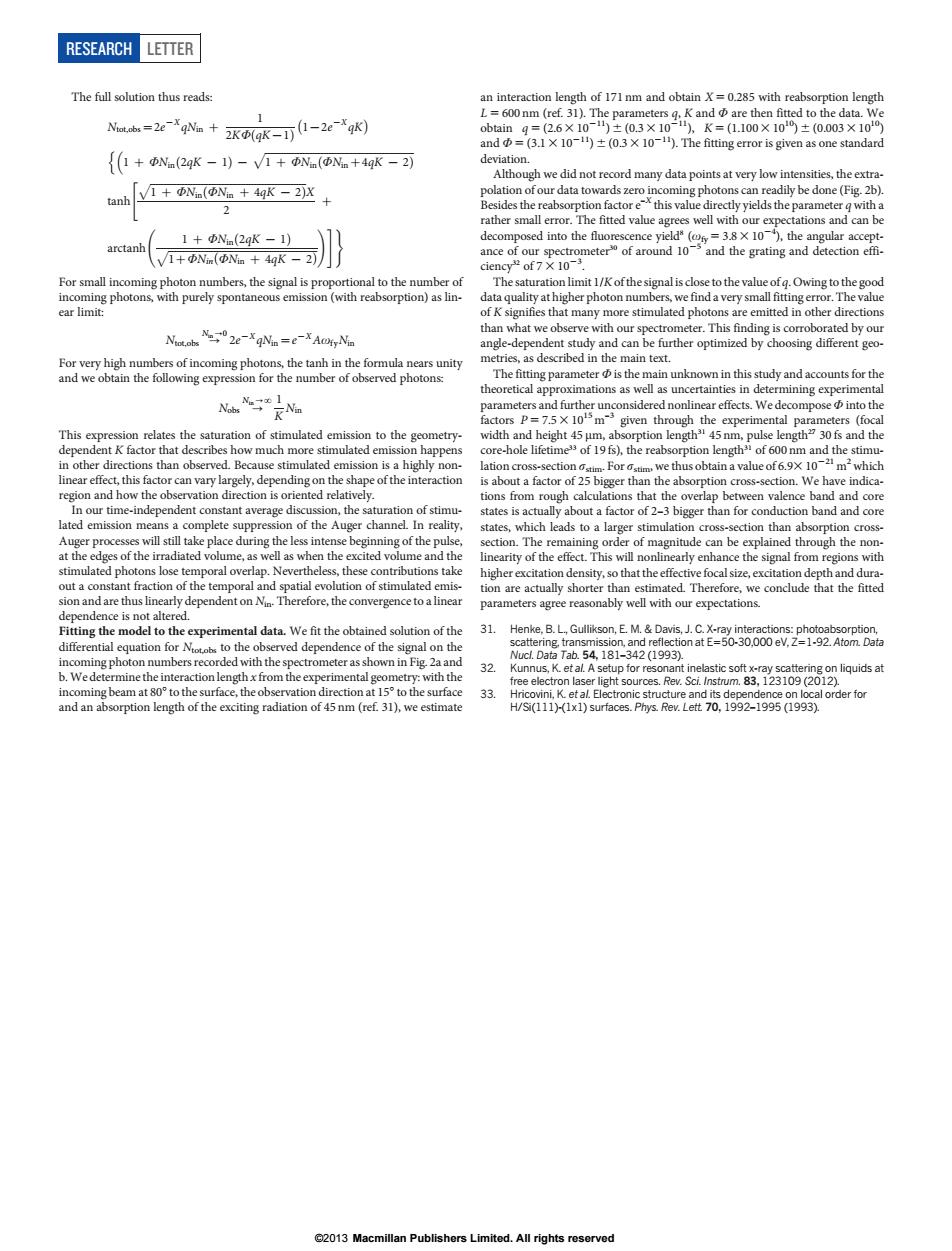正在加载图片...

RESEARCH LETTER The full solution thus reads n ir =24。+xk-可-24q {化+Na(24K-)-V+Na(®+4K-可 ah++K-亚, tted vah arctanh 1+Na(24k-1)] 1+NN。+4K-可】 g to the goo 2e-XNis =e-X Na The fitt in this dv and p=75X105m cu. We hav ofaonthut tal data.We fit the obtained solution of th 31. ptor nd an t nath of the exc ing radiation ofm (ref 31). 33. loderfor The full solution thus reads: Ntot,obs~2e {XqNin z 1 2KWð Þ qK{1 1{2e {XqK 1 z WNinð Þ 2qK { 1 { ffiffiffiffiffiffiffiffiffiffiffiffiffiffiffiffiffiffiffiffiffiffiffiffiffiffiffiffiffiffiffiffiffiffiffiffiffiffiffiffiffiffiffiffiffiffiffiffiffiffiffiffiffiffiffiffi 1 z WNinð Þ WNinz4qK { 2 n p tanh ffiffiffiffiffiffiffiffiffiffiffiffiffiffiffiffiffiffiffiffiffiffiffiffiffiffiffiffiffiffiffiffiffiffiffiffiffiffiffiffiffiffiffiffiffiffiffiffiffiffiffiffiffiffiffiffiffiffiffi 1 z WNinð Þ WNin z 4qK { 2 p X 2 z " arctanh 1 z WNinð Þ 2qK { 1 ffiffiffiffiffiffiffiffiffiffiffiffiffiffiffiffiffiffiffiffiffiffiffiffiffiffiffiffiffiffiffiffiffiffiffiffiffiffiffiffiffiffiffiffiffiffiffiffiffiffiffiffiffiffiffiffi 1zWNinð Þ WNin z 4qK { 2 p !#) For small incoming photon numbers, the signal is proportional to the number of incoming photons, with purely spontaneous emission (with reabsorption) as linear limit: Ntot,obs ? Nin?0 2e {XqNin~e {XAvfyNin For very high numbers of incoming photons, the tanh in the formula nears unity and we obtain the following expression for the number of observed photons: Nobs ?Nin?? 1 K Nin This expression relates the saturation of stimulated emission to the geometrydependent K factor that describes how much more stimulated emission happens in other directions than observed. Because stimulated emission is a highly nonlinear effect, this factor can vary largely, depending on the shape of the interaction region and how the observation direction is oriented relatively. In our time-independent constant average discussion, the saturation of stimulated emission means a complete suppression of the Auger channel. In reality, Auger processes will still take place during the less intense beginning of the pulse, at the edges of the irradiated volume, as well as when the excited volume and the stimulated photons lose temporal overlap. Nevertheless, these contributions take out a constant fraction of the temporal and spatial evolution of stimulated emission and are thus linearly dependent onNin. Therefore, the convergence to a linear dependence is not altered. Fitting the model to the experimental data. We fit the obtained solution of the differential equation for Ntot,obs to the observed dependence of the signal on the incoming photon numbers recorded with the spectrometer as shown in Fig. 2a and b.We determine the interaction length x from the experimental geometry: with the incoming beam at 80uto the surface, the observation direction at 15uto the surface and an absorption length of the exciting radiation of 45 nm (ref. 31), we estimate an interaction length of 171 nm and obtain X 5 0.285 with reabsorption length L 5 600 nm (ref. 31). The parameters q, K and W are then fitted to the data. We obtain q 5 (2.6 3 10211) 6 (0.3 3 10211), K 5 (1.1003 1010) 6 (0.0033 1010) and W 5 (3.1 3 10211) 6 (0.3 3 10211). The fitting error is given as one standard deviation. Although we did not record many data points at very low intensities, the extrapolation of our data towards zero incoming photons can readily be done (Fig. 2b). Besides the reabsorption factor e–X this value directly yields the parameter q with a rather small error. The fitted value agrees well with our expectations and can be decomposed into the fluorescence yield8 (vfy5 3.83 1024 ), the angular acceptance of our spectrometer30 of around 1025 and the grating and detection efficiency32 of 7 3 1023 . The saturation limit 1/K of the signal is close to the value of q. Owing to the good data quality at higher photon numbers, we find a very small fitting error. The value of K signifies that many more stimulated photons are emitted in other directions than what we observe with our spectrometer. This finding is corroborated by our angle-dependent study and can be further optimized by choosing different geometries, as described in the main text. The fitting parameter W is the main unknown in this study and accounts for the theoretical approximations as well as uncertainties in determining experimental parameters and further unconsidered nonlinear effects. We decompose W into the factors P 5 7.5 3 1015 m–3 given through the experimental parameters (focal width and height 45 mm, absorption length31 45 nm, pulse length27 30 fs and the core-hole lifetime33 of 19 fs), the reabsorption length31 of 600 nm and the stimulation cross-section sstim. For sstim, we thus obtain a value of 6.93 10221 m2which is about a factor of 25 bigger than the absorption cross-section. We have indications from rough calculations that the overlap between valence band and core states is actually about a factor of 2–3 bigger than for conduction band and core states, which leads to a larger stimulation cross-section than absorption crosssection. The remaining order of magnitude can be explained through the nonlinearity of the effect. This will nonlinearly enhance the signal from regions with higher excitation density, so that the effective focal size, excitation depth and duration are actually shorter than estimated. Therefore, we conclude that the fitted parameters agree reasonably well with our expectations. 31. Henke, B. L., Gullikson, E. M. & Davis, J. C. X-ray interactions: photoabsorption, scattering, transmission, and reflection at E550-30,000 eV, Z51-92. Atom. Data Nucl. Data Tab. 54, 181–342 (1993). 32. Kunnus, K. et al. A setup for resonant inelastic soft x-ray scattering on liquids at free electron laser light sources. Rev. Sci. Instrum. 83, 123109 (2012). 33. Hricovini, K. et al. Electronic structure and its dependence on local order for H/Si(111)-(1x1) surfaces. Phys. Rev. Lett. 70, 1992–1995 (1993). RESEARCH LETTER ©2013 Macmillan Publishers Limited. All rights reserved�